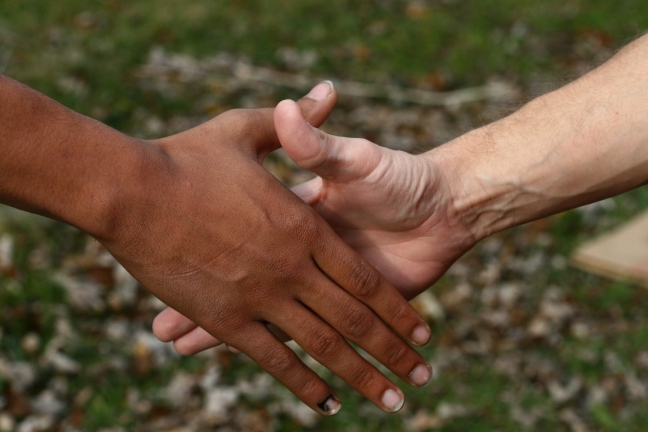African culture highlighted in seven-day Kwanzaa celebration

Unity, one of the seven principles of Kwanzaa, is quickly gaining popularity as one of the most important elements of the week-long celebration.
Photo by Stephanie Fenton
Celebrated annually from Dec. 26 through Jan. 1, Kwanzaa was created in 1966 by Maulana Karenga, a professor of African Studies at California State University, Long Beach, and is generally regarded as a time for African Americans to reconnect with their African heritage. In recent years, however, Karenga has urged everyone to honor Kwanzaa in a spirit of unity and peace.
“I think, essentially, that there are three parts of Kwanzaa: the factual part of it, the heart of it and the spirit of it,” said Richarde Donelan, an Ann Arbor resident who celebrates Kwanzaa.
“The factual part, of course, is that it was created in 1966 by Maulana Karenga and that there are seven principles to it; the heart of it is that this celebration originally came after the harvest, so it came after extensive work. I think that, in America, we’re too accustomed to celebrating - this needs to be a time of reflection, assessment and a time to move forward [and then to celebrate afterward]. The spirit of it is a spirit of connectivity with our ancestors, as well as with those we share the Earth with, which is any and everybody.”
During Kwanzaa, seven principles are honored, and one is highlighted each day: unity; self-determination; collective work and responsibility; cooperative economics; purpose; creativity; and faith.
Traditionally, African Americans decorate their homes with African art and cloths, wear traditional African clothing and eat fresh fruits during Kwanzaa, as this Kwanzaa - a Swahili word - takes the characteristics of the East African region. Many also light a candle holder, or kinara, and exchange handmade or useful gifts.
The 2009 theme is “Principles and Practices of Kwanzaa: Repairing and Renewing the World.”
According to Ann Arbor resident and retired teacher Cora Ssengoba, who says her house “looks like Kwanzaa every day,” the holiday should always be centered on repairing the world.
“The feelings of unity speak to the world, and we need to have diversity in unity,” said Ssengoba, who brought Kwanzaa programs to the many students she taught during a 30-year career in the Ann Arbor Public Schools. “Unity is a word that we need to embrace, and with it, we need to move in a positive direction.”
In 1997, Karenga made an announcement that parallels Ssengoba’s perspective on Kwanzaa: Rather than holding Kwanzaa as an alternative to Christmas or another religious holiday - as was part of the original intention - Karenga suggested that not only should Kwanzaa be an addition to one’s beliefs, but that anyone from any race can, and should, celebrate Kwanzaa, just as Americans mark Cinco de Mayo and the Chinese New Year.
For Ssengoba - who recently hosted a Kwanzaa party for local Baha’is and decorated some 20 tables with her personal collection of Kwanzaa decorations - the seven days have always been highlighted by time spent with family and friends. Although no specific dishes are incorporated in Kwanzaa, Ssengoba says she and her friends used to gather their families, cook their favorite dishes and light candles together.
“When we all had young children, we each took a night and would host everyone at our home,” explained Ssengoba. “It’s really not ritualized, so we would celebrate this way. And one of my favorite parts was passing the unity cup. When we’d pass the unity cup, we would each say what we would like to accomplish or would like help or prayer with in the coming year.”
In the spirit of unity, Ssengoba says, friends of many different ethnic backgrounds have celebrated Kwanzaa with her throughout the years. While she used to regard Kwanzaa as an African-American holiday during her younger years, she has come to see it as something that should be promoted as a unifying celebration that anyone can share in.
Kwanzaa originated around the Black Nationalist movement of the 1960s, and many long-time participants have changed their views as the years have passed, including Kwanzaa’s founder. Still, the focus on African culture remains, and many view Kwanzaa as a time to recognize its characteristics.
Last year, the first and only feature film about Kwanzaa was released, “The Black Candle,” which was narrated by Maya Angelou.
Richarde Donelan says that, as America has long been a collection of various cultures, a celebration like Kwanzaa helps many to better understand the African culture.
“We really have a hodge-podge of cultures in America, and I say that because they seem to be in competition with each other,” said Donelan. “But rather, they should co-exist with each other.”
Due to Kwanzaa’s link with personal observances, it is difficult to gage how many people celebrate it. The National Research Foundation reported in 2004 that approximately 4.7 million Americans uphold its traditions, while founder Karenga estimated in 2006 that Kwanzaa has 28 million followers. In a collection of essays, Lee D. Baker, associate cultural anthropology and African and African-American studies professor at Duke University, recently estimated 12 million.
Contributor Stephanie Fenton reports on faith for AnnArbor.com. Stephanie can be reached at Fenton.Stephanie@gmail.com.


Comments
Gfellow
Wed, Jan 6, 2010 : 11:16 a.m.
I wonder how many folks out there celebrate Festivus?